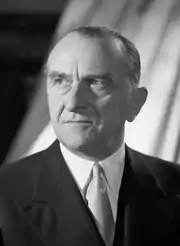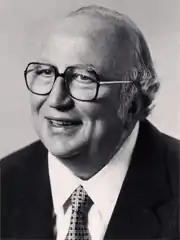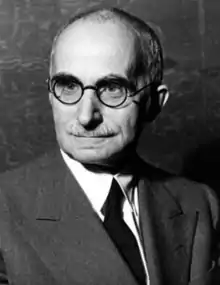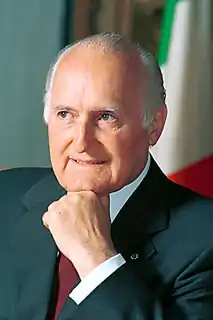List of presidents of Italy
Below is a list of the presidents of the Italian Republic with the title Presidente della Repubblica since 1948. The Quirinal Palace (known in Italian as the Quirinale) in Rome is the official residence of the president of the Italian Republic. The 12 Presidents came from only six of the 20 Regions: three each from Campania (all born in Naples) and Piedmont, two each from Sardinia (both born in Sassari) and Tuscany and one each from Liguria and Sicily. No woman has held the office yet.
 |
|---|
| This article is part of a series on the politics and government of Italy |
| Constitution |
| Foreign relations |
Election
The president of the Republic is elected by Parliament in a joint session of the Chamber of Deputies and the Senate. In addition, the 20 regions of Italy appoint 58 representatives as special electors. Three representatives come from each region, save for the small Aosta Valley which appoints one, so as to guarantee representation for all localities and minorities.
According to the Constitution, the election must be held in the form of secret ballot, with the 315 senators, the 630 deputies and the 58 regional representatives all voting. A two-thirds vote is required to elect on any of the first three rounds of balloting and after that a majority suffices. The election is presided over by the Speaker of the Chamber of Deputies, who calls for the public counting of the votes. The vote is held in the Palazzo Montecitorio, home of the Chamber of Deputies, which is expanded and re-configured for the event.
The president assumes office after having taken an oath before Parliament and delivering a presidential address. Presidents are elected to serve a seven-year term. Giorgio Napolitano is the only president to be elected to a second term.
Presidents of the Italian Republic (1946–present)
Timeline

Substitute of the head of state
The Acting President of the Republic (Italian: Presidente supplente della Repubblica) is an office not explicitly provided for in the Italian Constitution, but deriving from the provision contained in the article 86.[1] On various occasions, officials had to intercede in the absence of a head of state (notably in the case of a president's resignation or ill health). Only Enrico De Nicola, who was elected to be provisional head of state by the Constitutional Assembly on 28 June 1946, had an official title and took residence in the Quirinal Palace.[2] The others took the powers, but not the title of Head of State. After the adoption of the Italian Constitution in 1948, the president of the Senate is eligible to take the powers of head of state in case of absence of the President of the Republic.
| DC PLI PRI PPI PD Independent | ||||||||
|---|---|---|---|---|---|---|---|---|
| Portrait | Name (Born–Died) |
Term of office | Party | Election | Notes | |||
| Took office | Left office | Time in office | ||||||
| Provisional Head of State | ||||||||
 |
Alcide De Gasperi (1881–1954) |
12 June 1946 |
28 June 1946 |
16 days | Christian Democracy | — | [lower-alpha 8] | |
 |
Enrico De Nicola (1877–1959) |
28 June 1946 |
31 December 1947 |
1 year, 186 days | Italian Liberal Party | 1946 | [lower-alpha 9] | |
| Acting President of Italy | ||||||||
 |
Cesare Merzagora (1898–1991) |
6 December 1964 |
29 December 1964 |
23 days | Independent | — | [lower-alpha 10] | |
 |
Amintore Fanfani (1908–1999) |
15 June 1978 |
9 July 1978 |
24 days | Christian Democracy | — | [lower-alpha 11] | |
 |
Francesco Cossiga (1928–2010) |
29 June 1985 |
3 July 1985 |
4 days | Christian Democracy | — | [lower-alpha 12] | |
 |
Giovanni Spadolini (1925–1994) |
28 April 1992 |
28 May 1992 |
30 days | Italian Republican Party | — | [lower-alpha 13] | |
 |
Nicola Mancino (1931–) |
15 May 1999 |
18 May 1999 |
3 days | Italian People's Party | — | [lower-alpha 14] | |
 |
Pietro Grasso (1945–) |
14 January 2015 |
3 February 2015 |
20 days | Democratic Party | — | [lower-alpha 15] | |
Living former presidents of Italy
There is one living former Italian president:

Giorgio Napolitano
(age 95)
2006–2015
See also
- Lists of incumbents
- List of Italian Monarchs, for previous Italian heads of state between 1861 and 1946
- List of Italian Presidents by longevity
- List of presidents of Italy by time in office
- List of prime ministers of Italy
- Politics of Italy
- Prime Minister of Italy
Notes
- Resigned due to health reasons.
- Resigned due to a bribery scandal.
- Resigned in order to bring forward the inauguration ceremony of the President-elect.
- Resigned in order to favor the resolution of the political crisis after the 1992 general election.
- Ciampi was a member of the Action Party, which was dissolved in 1947.
- Resigned due to age reasons.
- Mattarella was a member of the Christian Democracy, of the Italian People's Party, of The Daisy and of the Democratic Party, but he quit political commitment when he left the Parliament in 2008.
- De Gasperi exercised the powers of provisional head of state as Prime Minister of Italy between the departure of King Umberto II on 12 June 1946 and the proclamation of Enrico De Nicola as head of state by the Constitutional Assembly on 28 June 1946.
- De Nicola was the only provisional president who had the title and not only the powers of provisional head of state. He assumed the office on 28 June 1946 and officially became the president of the Republic on 1 January 1948 as ordered by the new Constitution.
- Merzagora, as President of the Senate, assumed temporary powers for President Antonio Segni after his cerebral hemorrhage of 10 August 1964 and assumed full powers after his resignation of 6 December and until 29 December 1964.
- Fanfani, as President of the Senate, assumed powers from President Giovanni Leone after his resignation for a bribery scandal on 15 June 1978. He exercised the powers until 9 July 1978.
- Cossiga, as President of the Senate, assumed powers from President Sandro Pertini on 29 June 1985, just four days before taking office as President.
- Spadolini, as President of the Senate, assumed powers from President Francesco Cossiga on 28 April 1992. He exercised the powers until 28 May 1992.
- Mancino, as President of the Senate, assumed powers from President Oscar Luigi Scalfaro on 15 May 1999. He exercised the powers until 18 May 1999.
- Grasso, as President of the Senate, assumed powers from President Giorgio Napolitano on 14 January 2015. He exercised the powers until 3 February 2015.
References
- Articolo 86, Costituzione della Repubblica Italiana, Brocardi
- Decreto legislativo luogotenenziale, www.paralex.it
External links
- (in Italian) Presidenza della Repubblica – official site of the president of Italian Republic
| Wikimedia Commons has media related to Presidents of Italy. |



.jpg.webp)





